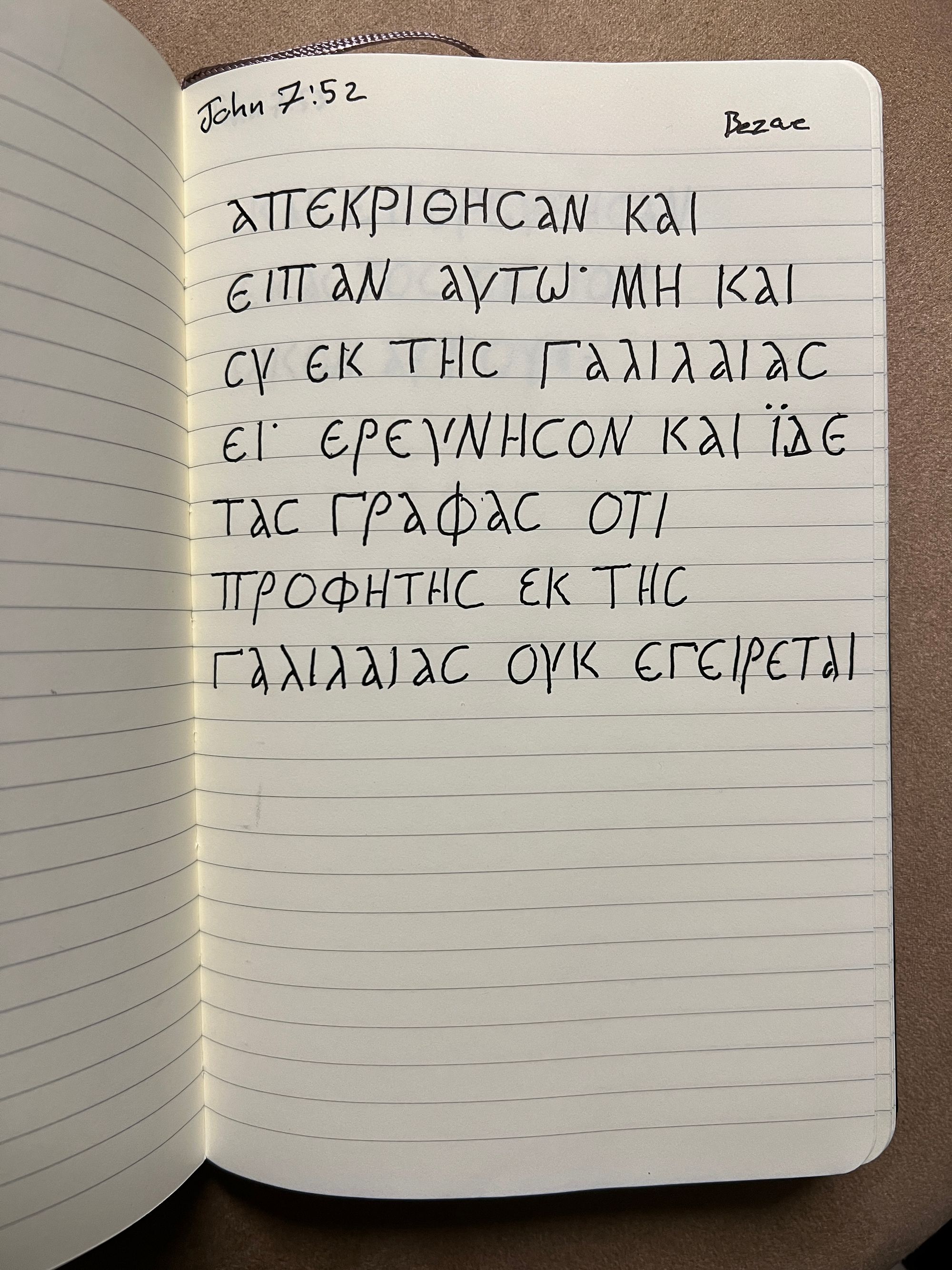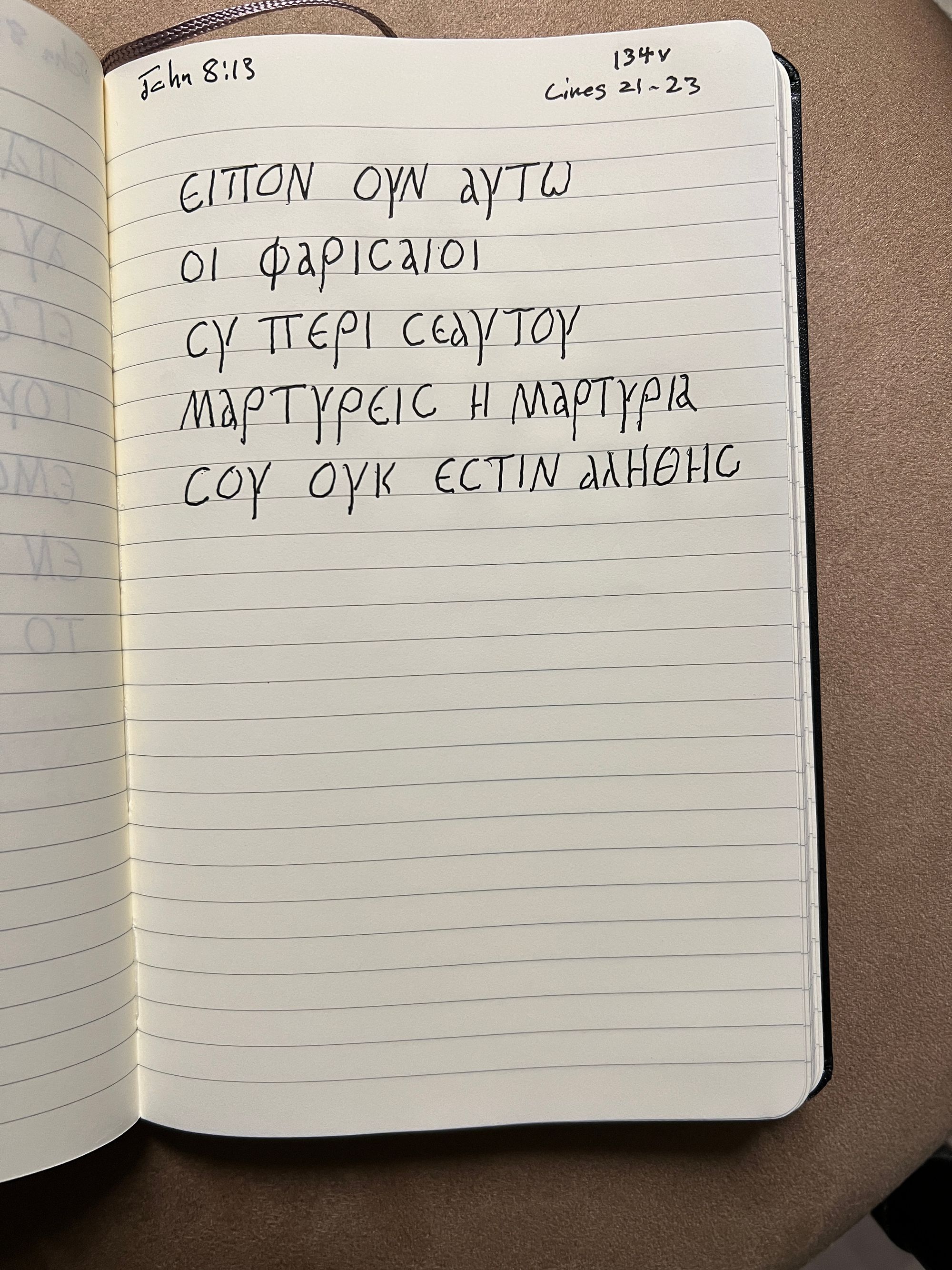Copying the Pericope Adulterae from Codex Bezae
I've started exploring the Pericope Adulterae and part of the process was hand-copying the the text from Code D (Bezea).

The process was pretty simple.
- Paper: 4.5" by 7" Moleskin journal
- Pen: Pilot G2 0.7
- Transcription: Codex Bezae Cantabrigiensis (Greek Pages), edited by Frederick H. Scrivener, published by Deighton, Bell and Co., Cambridge,
England, 1864 (Morphological tagging by Rex A. Koivisto
Multnomah University, Portland, Oregon USA) Copyright © 2009 OakTree Software, Inc. All rights reserved. Version 3.4 (a digital copy of the book is available at archive.org ) - Manuscript: University of Cambridge Digital Library (Codex Bezae - MS Nn.2.41)
Because I needed a process that would allow me to work on the go (when I wouldn't have the luxury of a full-size monitor), I was planning on just copying straight from the Accordance module in the iPad app. But that didn't work out (because the accordance module has errors) but also, as I became more comfortable with the script and the manuscript, I was able to work more and more directly from the images, consulting the transcription when word and line spaces made a reading difficult.
And with the high resolution images of the manuscript, for sure I had a much easier time of it than Scrivener. The entire time I was wondering what he would have thought about these space-age tools.
So, here's my attempt, with apologies to Dr. Koivisto for not being a more diligent Greek student and apologies to my mother for not doing my penmanship lessons.
John 7:52

Obviously, the difficult part was learning the new script. For example, I slip into the modern script with the ε in εκ on line 6. Spacing is also an issue. It's easier now after doing this a bit, but the extra space in ειπαν stands out here.
John 7:53

I screwed up the semi-colon here and scratched it out.
John 8:1

First instance of a nomina sacra in this passage. I love seeing them in the wild. It never gets old.
John 8:2

The "boring" verses are the ones that most intrigue me. We tend to freak out over the ones that have interesting features and stories. But it stands out to me when a verse is basically stable and boring. We don't talk about those enough.
John 8:3

I definitely missed the ρ in αμαρτεια. Also not sure what's going on with the (even more) terrible penmanship in the last 2.5 lines. This may be when I switched over to copying directly from the image of the manuscript rather than from the Scrivener transcription.
John 8:4

I think I misjudged where the word division was for εκ πειραζοντες and I for sure misjudged the word length for κατειληπται.
John 8:5

This was my first variant discovery and it threw me off a bit, so I just re-started the whole page. The issue is that the Scrivener transcription adds ημιν after νομω (this is Bezae next to NA28 in Accordance)
Here's the University of Cambridge images:

And the transcription next to the NA28

The digitized copy on Archive.org doesn't have it either:

All of which suggests that somewhere between Scrivener and the Accordance module, the variant was introduced.
So that's pretty cool.
John 8:6

You can tell when I get overly ambitious about what will fit on a line.
John 8:7

If memory serves, I was having trouble finding where I left off between copy sessions, so started adding the folio reference, the digital image number, and the line in the header. This was helpful when my the browser forced me to reload the web page (the current Cambridge Digital library doesn't allow you to browse by verse, so the only way to find the passage is by going through the manuscript a page at a time, an annoyingly realistic experience).
Also jacked up the η in αυτην.
John 8:8

Again with the line endings.
John 8:9

Here I reverted scripts with the σ in πρεσβυτερων. Also added the second α in κατα instead of the augment for κατελειφθη.
John 8:10

Second nomina sacra. Also another delightfully normal text.
John 8:11

Another nomina sacra over κυριε. That's interesting to me because I prefer the "sir" translation.
Also, another example of variation in the digitalization process. Here's the manuscript:

Here's Accordance/Scrivener:

And Scrivener:

John 8:12

The thing I love most about this controversy is that the "light of the world" declaration in 8:12 is possibly the most stable verse in the entire section.
John 8:13

And the last page.
Reflections
I learned a ton from this process and even more since then. Mostly my personal reflection has been how profoundly rich I am. I have tools and resources that the Scrivener couldn't imagine. Or maybe he did. For sure, whoever the scribe was, couldn't imagine a world where copy/paste, zooming into the text, and consulting facimalies was as easy as clicking.
And they probably couldn't imagine that someone living in such a science-fiction world would waste his time copying text by hand.

Member discussion